
|
| Family Trees -> Barth Dunham Fitz Randolph Freeman Giles Ilsley Jackson Luthin Venable Waldershelf Wilson |

|
| Family Trees -> Barth Dunham Fitz Randolph Freeman Giles Ilsley Jackson Luthin Venable Waldershelf Wilson |
I thought I'd take the occasion of the 150th anniversary of the War Between the States (1861-1865) to remind us of the service of our ancestors. This page is in honor of a few of my ancestors that fought in the US Civil War and for whom I have a documented relationship and service record. There are others that served for the Union side from NJ and New England with whom I only suspect a relation. I know that there are more distant cousins that served the southern cause. All Singletary's, as well as, some Dunham's, Giles's and Jackson's in the Confederate Army are also related.
The four veterans profiled below include a great grandfather and three great uncles. Their service, experiences, and stories vary. Each in their own way is quite remarkable as one might expect of the individual tales of all that served - either North or South. I hope you enjoy these stories of distinguished service to the United States of America and their personal perspective on historical events.
Click on a section title below to learn more about the next events in this adventure or open all sections and browse.
 Great Grandpa Henry R Wilson (b. 12 Mar 1844 in prob. Halifax, Nova Scotia, Canada; d. 1 Apr 1916 in Perth Amboy, NJ) son of British Merchant Marine Henry T. Wilson and an Irish-born lass, Elizabeth Nelson, emigrated to the U.S. apparently just in time for the civil war. Perhaps he saw the move as a chance for service and adventure.
Great Grandpa Henry R Wilson (b. 12 Mar 1844 in prob. Halifax, Nova Scotia, Canada; d. 1 Apr 1916 in Perth Amboy, NJ) son of British Merchant Marine Henry T. Wilson and an Irish-born lass, Elizabeth Nelson, emigrated to the U.S. apparently just in time for the civil war. Perhaps he saw the move as a chance for service and adventure.
Henry enlisted in 1861 at the age of 17. Served in the US Navy as a rigger from 1861 to 1865 and again from 1868 to 1871. During the Civil War he sailed on the Union Warship USS Kearsarge, famous for its large caliber pivot gun used to defeat the CSS Alabama off the coast of Cherbourg, France. A painting of the ship is part of the US Naval Museum to commemorate its service. Click on the photo for more images.
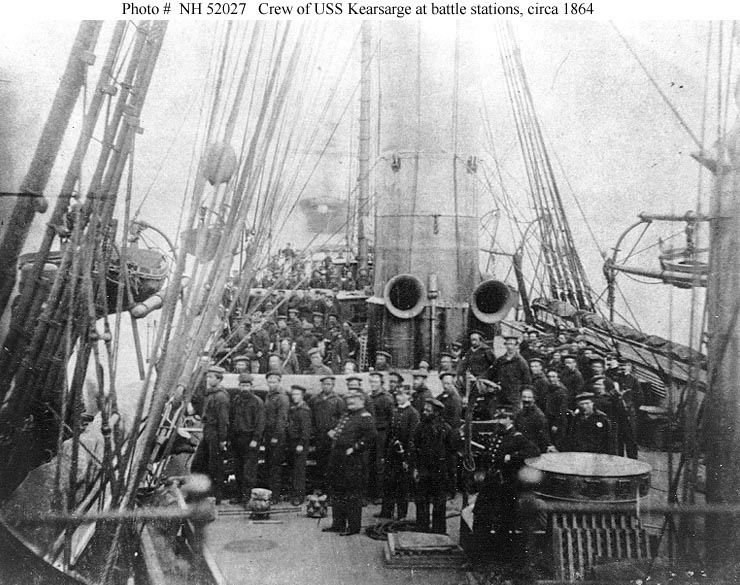 USS Kearsarge, a 1550-ton Mohican class steam sloop of war, was built at the Portsmouth Navy Yard, Kittery, Maine, under the 1861 Civil War emergency shipbuilding program. She was commissioned in January 1862 and almost immediately deployed to European waters, where she spent nearly three years searching for Confederate raiders.
USS Kearsarge, a 1550-ton Mohican class steam sloop of war, was built at the Portsmouth Navy Yard, Kittery, Maine, under the 1861 Civil War emergency shipbuilding program. She was commissioned in January 1862 and almost immediately deployed to European waters, where she spent nearly three years searching for Confederate raiders.
In June 1864, while under the command of Captain John Winslow, Kearsarge found CSS Alabama at Cherbourg, France, where she had gone for repairs after a devastating cruise at the expense of the United States' merchant marine. On 19 June, the two ships, nearly equals in size and power, fought a battle off Cherbourg that became one of the Civil War's most memorable naval actions. In about an hour, Kearsarge's superior gunnery completely defeated her opponent, which soon sank.
After searching off Europe for the Confederate cruiser Florida, Kearsarge went to the Caribbean, then to Boston, where she received repairs before returning to Europe in April 1865 to try to intercept the ironclad CSS Stonewall. With the end of the Civil War, she remained in the area until mid-1866, when she was placed out of commission.
Kearsarge returned to active service in January 1868 and was sent to the Pacific coast of South America. During 1869, she cruised across the ocean as far as Australia, then returned to Peru. The next year, Kearsarge sailed north to Hawaii, then moved on to Mare Island, California, where she decommissioned in October 1870.
The 27 year old veteran rigger, Henry, married Amanda Turner Dunham on 14 July 1871. Amanda was the daughter of a rope maker Joseph Dunham and seamstress Isabella Jackson Dunham; granddaughter of farmer and militaman Joseph Dunham; and great granddaughter of farmer and American Revolution Patriot Josiah Dunham; and great great granddaughter of Patriot Captain Elisha Dunham. By 1880, Henry and Amanda had Henry R. Jr. (b.1873, who later changed his name to Harry R.), Amanda (b.1875), Alfred (b.1878), and Evangeline (b.1880). Henry then worked at the clay mines. By 1890, they had three more children: Ida (b.1883), Charles (b.1885), and Oscar (b.1887). Lastly, they had Arthur in 1891.
Henry died on 1 April 1916, in Perth Amboy, NJ, age 72. He is buried at the 1st Presbyterian Church Cemetery in Woodbridge. His wife, Amanda, also died in Perth Amboy on the 4th of February 1925. She is buried next to her husband.
Great Great-Uncle John T. Jackson (b.1825 in NJ; d.1894 in Woodbridge, NJ) was the brother to my Great Great Grandma Isabella (Jackson) Dunham and uncle to my Great Grandma Amanda T. Dunham, wife of Civil War Navy veteran Henry R. Wilson (above). In 1850, at age 25, he and other siblings to Isabella were farm neighbors of or living with Isabella and her husband, Joseph Dunham, just four years after Isabella and Joseph married. Both Jackson parents had died before that marriage. In 1860, he was married with four children age five or less and working as a Clay Carter at the Woodbridge clay mines.
At age 37, John enlisted in the Union army on 30 Aug 1862. With 939 others from Middlesex, Monmouth, Ocean, Camden and Gloucester counties (including Great Great-Uncle Joel Giles, below), he mustered into the 28 New Jersey Volunteer Infantry, Company F, as a Private on 22 September 1862. According to this post and a brief regimental history from The Union Army, vol. 3, reported at Ancestry.com, during John's service his regiment left Freehold, NJ, for Washington, D.C. on October 4, 1862.
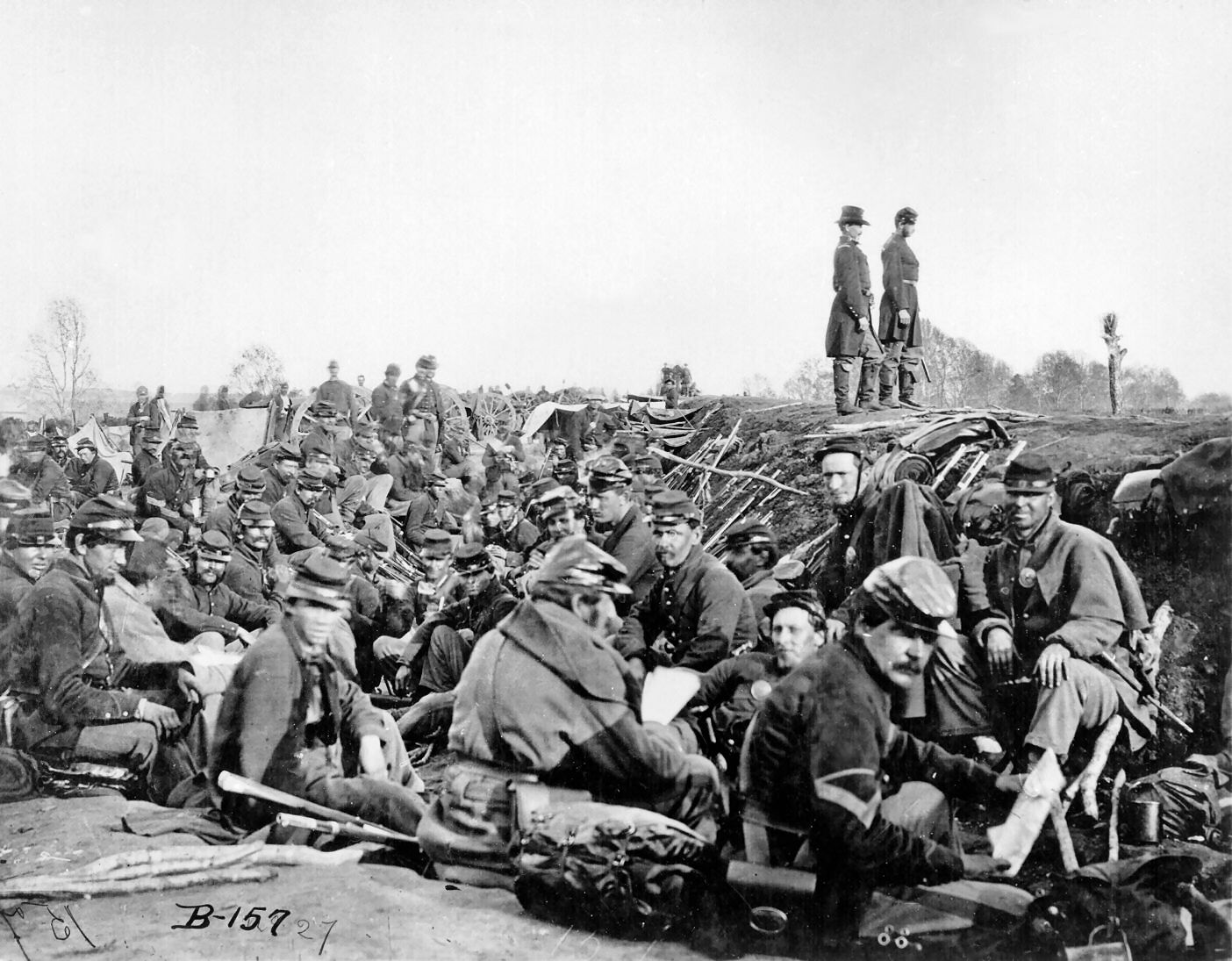 They reached Washington on the night of the 5th and encamped on Capitol Hill, where they were furnished a few days afterward with Springfield muskets. On the 13th they marched into Virginia and attached to Gen. Abercrombie's Provisional Brigade, Casey's Division for the Defenses of Washington from October until December, 1862.
They then became part of the 2nd Army Corps of the Army of the Potomac in the 1st Brigade, 3rd Division commanded by Maj. Gen. Darius N. Couch and Brig. Gen. John Gibbon, and marched to Falmouth, Va., from December 1-9 where they prepared for their first engagement.
They reached Washington on the night of the 5th and encamped on Capitol Hill, where they were furnished a few days afterward with Springfield muskets. On the 13th they marched into Virginia and attached to Gen. Abercrombie's Provisional Brigade, Casey's Division for the Defenses of Washington from October until December, 1862.
They then became part of the 2nd Army Corps of the Army of the Potomac in the 1st Brigade, 3rd Division commanded by Maj. Gen. Darius N. Couch and Brig. Gen. John Gibbon, and marched to Falmouth, Va., from December 1-9 where they prepared for their first engagement.
Col. Moses N. Wisewell, who "took charge of the regiment at its organization, was a man of fine intellectual capacity and soon acquired a marked hold on the confidence of the men, which he retained until November following, when, obtruding upon his command in a public address certain offensive avowals with reference to the war and the gubernatorial contest then in progress in New Jersey, he became obnoxious to a large portion of the regiment."
From December 12-15, 1862, they fought in the 1st Battle of Fredericksburg, Va., a major defeat for the Union and newly promoted General Burnside. Wisewell's "courage, however, was undoubted. While at the battle of Fredericksburg, he led his regiment with great gallantry, falling severely wounded and being carried from the field." Lieut.-Col. Edward A. L. Roberts came from New York and commanded the regiment from Dec. 14, 1862, until Jan. 2, 1863, when he was "discharged for tendering his resignation in the face of the enemy." Maj. Samuel K. Wilson, Jr. then commanded the regiment for a short time.
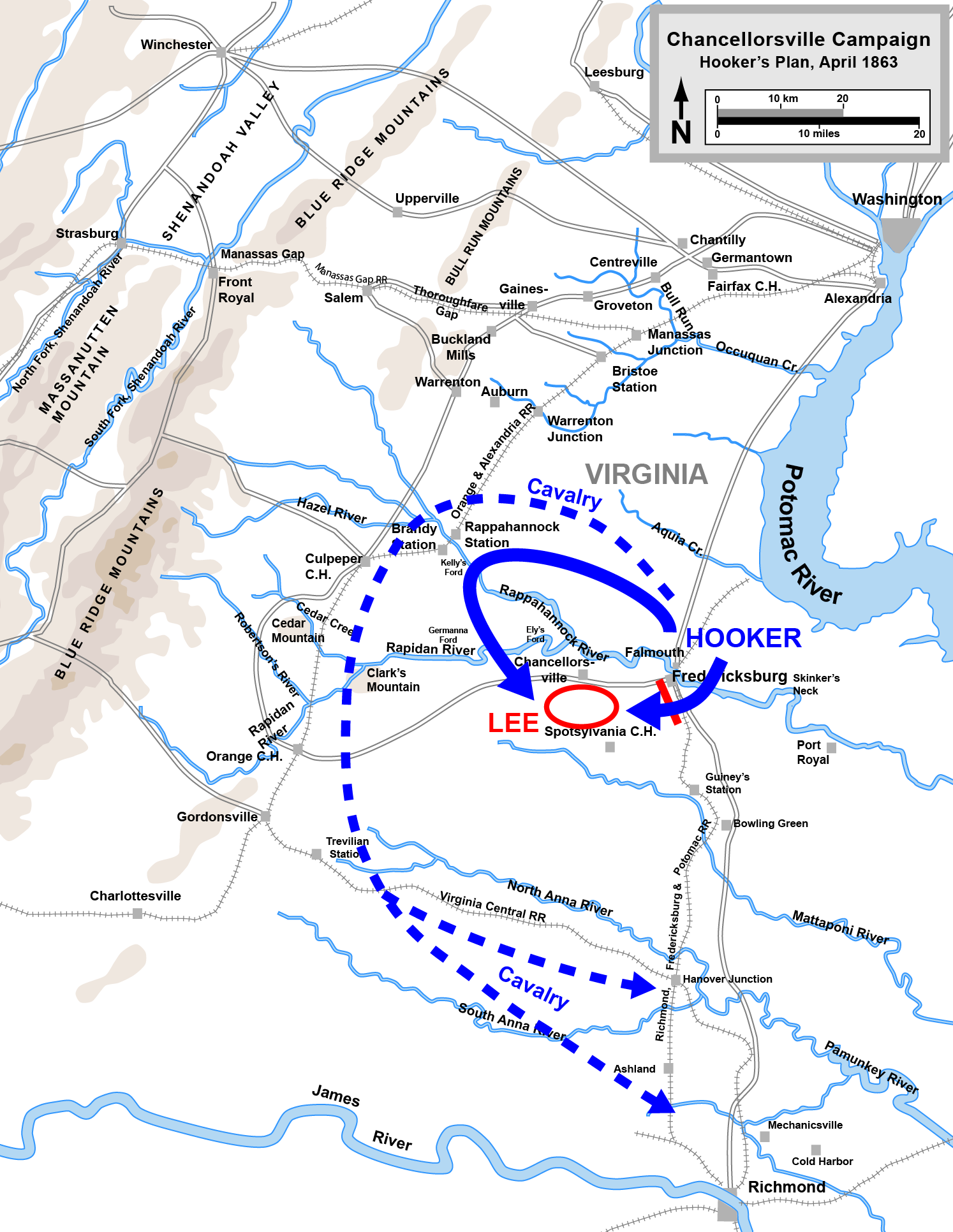 The regiment was then withdrawn to Falmouth, Va., until April, 1863. Lieut.-Col. John A. Wildrick, who had been a captain in the 2nd regiment, then "assumed command and by his sound judgment and wise exercise of authority, soon made the regiment one of the most effective in the brigade to which it belonged." The Chancellorsville Campaign began on April 27. This was a series of battles starting with the 2nd Battle of Fredericksburg at Marye's Heights; followed by the Battle of Salem Church in Spotsylvania, Va., setting up Stoneman's 1863 Calvary Raid on Fredericksburg; and culminating in the Battle of Chancellorsville from May 1-5. Wildrick "led the regiment with great bravery in the battle of Chancellorsville, where he was taken prisoner, but being exchanged returned to the field shortly afterward." Major Wilson again took command during Wildrick's absence. In June, Colonel Wisewell returned until the regiment's term of service expired.
The regiment was then withdrawn to Falmouth, Va., until April, 1863. Lieut.-Col. John A. Wildrick, who had been a captain in the 2nd regiment, then "assumed command and by his sound judgment and wise exercise of authority, soon made the regiment one of the most effective in the brigade to which it belonged." The Chancellorsville Campaign began on April 27. This was a series of battles starting with the 2nd Battle of Fredericksburg at Marye's Heights; followed by the Battle of Salem Church in Spotsylvania, Va., setting up Stoneman's 1863 Calvary Raid on Fredericksburg; and culminating in the Battle of Chancellorsville from May 1-5. Wildrick "led the regiment with great bravery in the battle of Chancellorsville, where he was taken prisoner, but being exchanged returned to the field shortly afterward." Major Wilson again took command during Wildrick's absence. In June, Colonel Wisewell returned until the regiment's term of service expired.
During their service the regiment lost 51 enlisted men killed and mortally wounded; and 1 officer and 31 enlisted men by disease; for a total of 84. John T. Jackson mustered out with the rest of the regiment at Freehold, NJ on July 6, 1863.
By 1870 (p2), he becomes a stone mason and has two more children. In 1880, John is working in the clay mine, like most of his neighbors and one of his sons. He survived the war perhaps with some injury since his 1890 pension record classifies him as "invalid". Since this record is from 1890 and not earlier, it May be that this term was simply left on the form from use under previous rules. The original 1890 Veterans Schedule record seems unclear due to miscellaneous specks on the copy and the method of marking dittos of the previous line(s). The record might indicate he was "shot through the body". It's also important to note that in 1890 the pension law was changed to include all veterens regardless of injury. It could also be that he did not suffer from a war injury until later in life. It would be fortunate if he wasn't injured. Both of the regiment's major battles were infamous for the casualties.
By 1894, John dies and is buried in the First Presbyterian (White) Church Cemetery according to a find-a-grave posting. (I recently sent an update for the birth and death dates.) His widow, Rachel Ann (maiden name unknown) Jackson, filed for widow's benefits in 1894. She is likely buried next to her husband. My Uncle Bob recorded notes that most of that family is buried together, but indicated they are at the Trinity Church across Trinity Lane from the White Church. I yet need to visit and check all the records in detail.
Great Great-Uncle Joel Giles (b. 1844 in NJ; d. by 1909 in NJ) was the son of my Great (3x) Grandparents Runyon Giles and Jane Gilman. He is a brother to my Great Great Grandma Mary Geargeine (Giles) Venable, married to GGreat Grandpa William Venable. At age 18, Joel enlisted as a musician (drummer) in Company C, 28th New Jersey Volunteer Infantry Regiment on 30 August 1862. As a drummer he played a special role throughout his tour of duty. See more details about musicians at the end of this history. Try the links to videos and music clips posted at Wikipedia and elsewhere.
Joel mustered in at Freehold to a different company than my Great Great-Uncle John T Jackson (above) yet the the regimental history below is as stated above. They also left Freehold, NJ, for Washington, D.C., on October 2, 1862. They reached Washington on the night of the 5th and encamped on Capitol Hill, where they were furnished a few days afterward with Springfield muskets. On the 13th they marched into Virginia and attached to Gen. Abercrombie's Provisional Brigade, Casey's Division for the Defenses of Washington from October until December, 1862. They then became part of the 2nd Army Corps of the Army of the Potomac in the 1st Brigade, 3rd Division commanded by Maj. Gen. Darius N. Couch and Brig. Gen. John Gibbon, and marched to Falmouth, Va., from December 1-9 where they prepared for their first engagement.
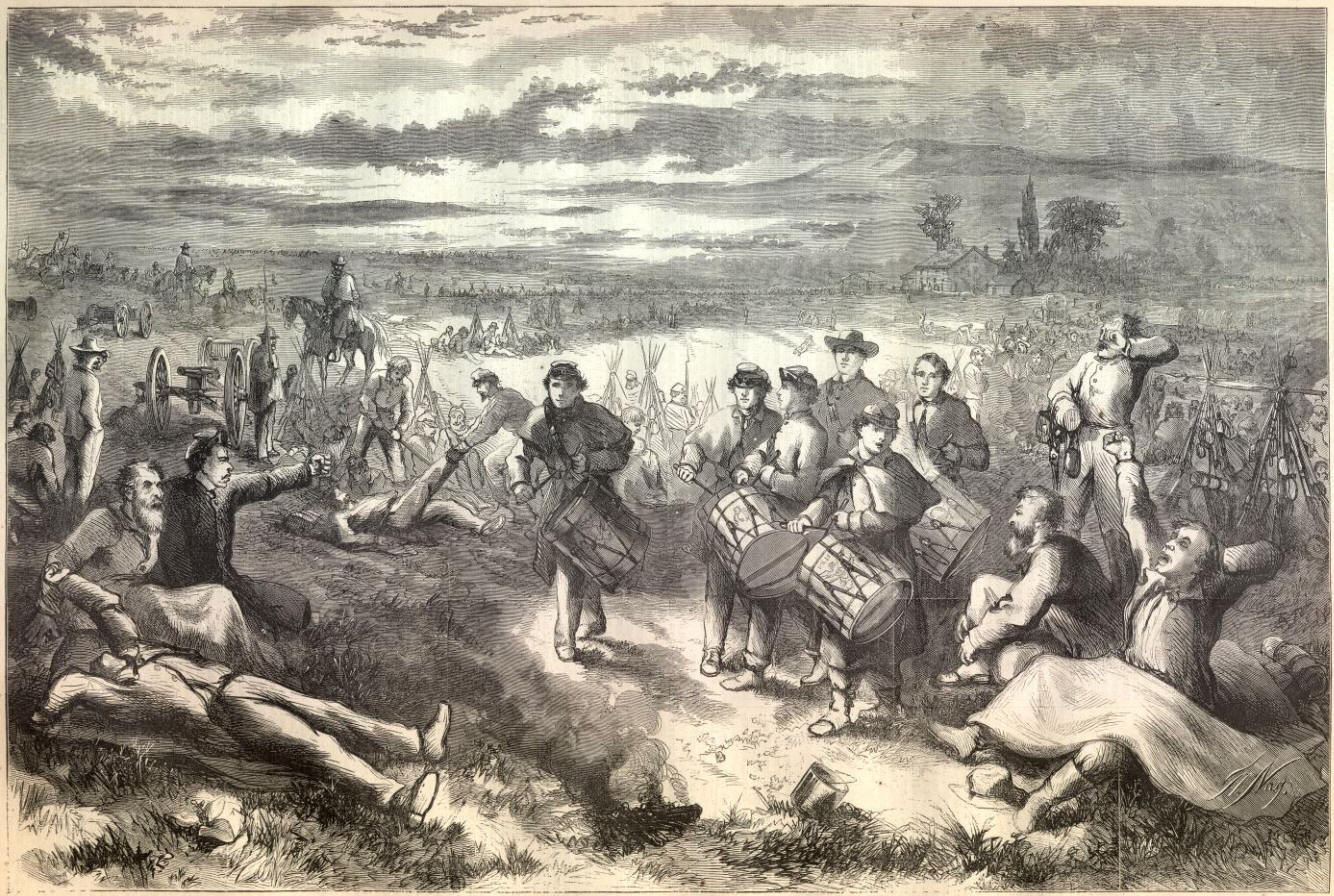 Col. Moses N. Wisewell, who "took charge of the regiment at its organization, was a man of fine intellectual capacity and soon acquired a marked hold on the confidence of the men, which he retained until November following, when, obtruding upon his command in a public address certain offensive avowals with reference to the war and the gubernatorial contest then in progress in New Jersey, he became obnoxious to a large portion of the regiment."
Col. Moses N. Wisewell, who "took charge of the regiment at its organization, was a man of fine intellectual capacity and soon acquired a marked hold on the confidence of the men, which he retained until November following, when, obtruding upon his command in a public address certain offensive avowals with reference to the war and the gubernatorial contest then in progress in New Jersey, he became obnoxious to a large portion of the regiment."
From December 12-15, 1862, they fought in the 1st Battle of Fredericksburg, Va., a major defeat for the Union and newly promoted General Burnside. Wisewell's "courage, however, was undoubted. While at the battle of Fredericksburg, he led his regiment with great gallantry, falling severely wounded and being carried from the field." Lieut.-Col. Edward A. L. Roberts came from New York and commanded the regiment from Dec. 14, 1862, until Jan. 2, 1863, when he was "discharged for tendering his resignation in the face of the enemy." Maj. Samuel K. Wilson, Jr. then commanded the regiment for a short time.
The regiment was then withdrawn to Falmouth, Va., until April, 1863. Lieut.-Col. John A. Wildrick, who had been a captain in the 2nd regiment, then "assumed command and by his sound judgment and wise exercise of authority, soon made the regiment one of the most effective in the brigade to which it belonged." The Chancellorsville Campaign began on April 27. This was a series of battles starting with the 2nd Battle of Fredericksburg at Marye's Heights; followed by the Battle of Salem Church in Spotsylvania, Va., setting up Stoneman's 1863 Calvary Raid on Fredericksburg; and culminating in the Battle of Chancellorsville from May 1-5. Wildrick "led the regiment with great bravery in the battle of Chancellorsville, where he was taken prisoner, but being exchanged returned to the field shortly afterward." Major Wilson again took command during Wildrick's absence. In June, Colonel Wisewell returned until the regiment's term of service expired.
During their service the regiment lost 51 enlisted men killed and mortally wounded; and 1 officer and 31 enlisted men by disease; for a total of 84. Joel mustered out with the rest of the regiment at Freehold, NJ on July 6, 1863.
On September 16, 1863, he applied for a pension, classified as an "invalid". I still wonder just what that really means. He married Melvina "Amelia" Merrill in 1867 at Bound Brook, NJ, and had seven children with her from 1868 through 1887. By 1880 he was living in Newark, NJ, and working as a Railroad Laborer. He became a Railroad Station Engineer by 1900. He seems to have died by 1909 when Melvina filed for his Civil War Veteran pension as his widow. I do not have a date or location of burial.
More Info on Civil War Musicians
 Wikipedia has a nice piece on the role music played in War Between the States. Musicians helped to rally the troops, drummers kept a cadence on marches, and buglers rendered specific calls at the behest of commanders to instruct the troops in the heat of battle when their voices would not be heard. They would also play as a group in the campground to entertain the troops and sometimes compete with nearby enemy bands the night before a battle. Read more at Music of the American Civil War with links to recordings like this one from 1909, Tenting on the Old Camp Ground. That song was a favorite of my father. Although, I do not recall him singing all the words. That's understandable after reading and/or listening to the lyrics.
Wikipedia has a nice piece on the role music played in War Between the States. Musicians helped to rally the troops, drummers kept a cadence on marches, and buglers rendered specific calls at the behest of commanders to instruct the troops in the heat of battle when their voices would not be heard. They would also play as a group in the campground to entertain the troops and sometimes compete with nearby enemy bands the night before a battle. Read more at Music of the American Civil War with links to recordings like this one from 1909, Tenting on the Old Camp Ground. That song was a favorite of my father. Although, I do not recall him singing all the words. That's understandable after reading and/or listening to the lyrics.
Important to keeping up the troops’ marching rhythm, as well as their war spirit and resolve, this original Civil War Union drum (right) was used in several Virginia battles including Fredericksburg and Chancellorsville. With it are the original straps and sticks. The drum is among the many original Civil War pieces that the museum exhibits, alongside several Civil War rifles, recruitment broadsides, diaries, and personal effects soldiers carried with them into battle and camp life.
Great Great-Uncle Runyon V Giles was born 14 Feb 1845 in Franklin Twp., Somerset Co., NJ. I do not have evidence but can't resist speculating that the V stands for Valentine. In 1860, just one year before the war, he and his older brother, Joel Giles (above), were living with their parents and other siblings on a rented farm in Piscataway Twp., Middlesex Co.
 On 13 Jan 1864, a month before his 19th birthday and several months after his brother, Joel, returned from service with injuries, Runyon enlisted as a Private in the Union Army for an 18 month service, the remainder of the war. He mustered into Company B of the 9th NJ Volunteers, a regiment of riflemen, at about the time that two-thirds of the regiment came home on a 30-day furlough. It was a reward for reenlisting at the close of their first term. The following is a regimental history taken from The Union Army by Federal Publishing Company, 1908 - Volume 3, as posted at the Civil War Index. The reader may also find interesting some "regimental lore" from local news articles and letters now posted online.
On 13 Jan 1864, a month before his 19th birthday and several months after his brother, Joel, returned from service with injuries, Runyon enlisted as a Private in the Union Army for an 18 month service, the remainder of the war. He mustered into Company B of the 9th NJ Volunteers, a regiment of riflemen, at about the time that two-thirds of the regiment came home on a 30-day furlough. It was a reward for reenlisting at the close of their first term. The following is a regimental history taken from The Union Army by Federal Publishing Company, 1908 - Volume 3, as posted at the Civil War Index. The reader may also find interesting some "regimental lore" from local news articles and letters now posted online.
The 9th was commanded by Cols., Joseph W. Allen, Charles A. Heckman, Abram Zabriskie, James Stewart, Jr.; Lieut.-Cols., James Wilson, William B. Curlis, Samuel Hufty; and Maj., Thomas B. Appleget. Since the regiment was formed in 1861, it had gained a reputation for courageous action and much success amid great personal loss on the Union side while operating deep in Confederate territory - the Carolinas.
The regiment's first engagement was at the Battle of Roanoke Island, where 9 men were killed and 25 wounded. They gained the nickname of The Jersey Muskrats, for mucking through deep mud. The 9th suffered 4 killed and 58 wounded in the Battle of New Berne, N.C., where the union lost one-sixth of its entire force. Late in 1862 at Rawle's Mill, it crossed a burning bridge and routed the enemy strongly posted beyond. Then there were engagements at Deep Creek, Southwest Creek, and Kinston before moving on to Goldsboro and then heading back toward New Berne. In July 1863, it joined other forces near there to take a bridge on the river Trent enabling the cavalry to cross. They yet participated in an affair at Winston toward the year's end and the completion of their enlistment.
In February 1864, just after Runyon enlisted, the Paterson Daily Guardian published the following item. "A number of the 9th Regiment are in town. These boys have smelled powder a great many times. They have re-enlisted and will take on any fighting men they can find, as they want a few recruits. Nobody who is afraid of a fight must join these boys, as they count themselves "in" upon nearly every occasion. They are a brave lot of good fellows."
Runyon would likely have joined the remaining one-third after their later reconnaissance near Deep Creek, VA, where the enemy was found in strong numbers. The regiment, diminished in strength by the furloughs, "was compelled to retreat, leaving the bodies of Albert Nutt and Joel Hulse, of Co. D, in the hands of the Confederates." A letter to the editor of The Beacon references this event with: "after killing poor Nutt, stripped him and threw his body into a ditch, whence it was afterward recovered by our boys. The secret of this disturbed hornets nest on this frontier, is probably this - the rebels are making a desperate effort to recover North Carolina, and they are attacking us here to prevent our sending more troops to Newbern and other places in eastern N.C. They seem now to be making one last desperate effort to retrieve their waning fortunes. If they are foiled in the coming campaign the work is done, the Union saved, and the future glory of our nation secure."
The Beacon of Lambertville published this description of the first days Runyon would have experienced. "A detachment of the 9th N.J.V. including the veterans who did not re-enlist and the recruits, removed from Newport News to this place, on the 22d and 23d of Jan. Here we have had comfortable quarters and rations, and generally a quiet time. The only exceptions have been occasional picket skirmishing within from four to eight miles of this place. We are about 5 miles from Portsmouth by way of Getty's Station, and about 3 miles by direct course. The 10th New Hampshire, and 8th Conn. Are stationed near us. We have near us several pine-log breastworks of several miles in extent, also several forts with big guns ready to spout iron hail and thunder whenever the rebs show themselves. At Getty's Station about 2 miles from here, are stationed several regiments and batteries. All these forces are under the command of Gen. Heckman, who formerly won such laurels in North Carolina. The Chivalry [sic]till quite recently have kept themselves at respectful distance. They have occasionally given us alarm by driving in our outer pickets. One night about three weeks since we had distributed to each man forty rounds of cartridges, with the expectation of having a chance before morning of burning said cartridges under the noses of unwelcome visitors. "
"On April 14, 'Heckman's old brigade' embarked at Portsmouth and sailed up the Chuckatuck River, landing on the following day at Cherry Grove, the enemy being met near that point and engaged by several companies of the 9th, with a loss of a number of men wounded. The regiment participated in the unequal contest at Port Walthall Junction, Va., and after continuing the engagement for about two hours retired, but on the following day the contest was renewed and the regiment lost in these two days of fighting 53 men in killed and wounded.
"The next day being Sunday, the regiment remained in camp, but on Monday morning both corps of Butler's command moved southward to Swift Creek, 3 miles from Petersburg — Heckman's brigade having the advance. The loss of the 9th in the ensuing engagement was 1 man killed and 9 wounded. On the following day Heckman's brigade was not engaged, but on the 12th the whole army again advanced, encountering the enemy on the Richmond & Petersburg railroad. It being rumored that the Confederates were evacuating Fort Darling at Drewry's Bluff. Gen. Heckman dispatched Capt. Samuel Hufty with 100 men of the 9th to reconnoiter the enemy's position, which duty was satisfactorily performed, the party returning before daylight of the 14th with a report that the enemy still occupied the fort, their lines being established as during the previous day.
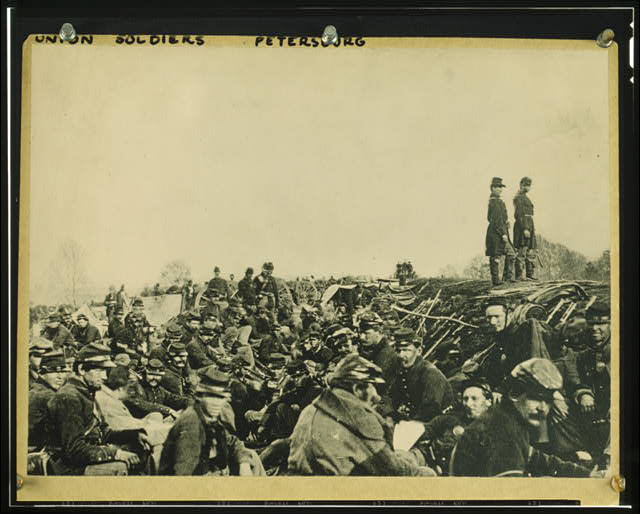 "Then followed the Battle of Drewry's Bluff, in which the 9th lost heavily, over 50 per cent, of those engaged. At the commencement of the engagement the regiment had 19 officers, 13 of whom were either killed or wounded, and 3 were taken prisoners. From first to last the men fought with characteristic gallantry. Reaching the scene of action at Cold Harbor on June 3, the 9th was ordered to the front line and almost immediately became engaged. Grant having determined to pass the Chickahominy far to Lee's right. Gen. Smith's corps gradually withdrew from its position — the 9th covering the withdrawal — and marched directly to White House, where it embarked for Bermuda Hundred. The total loss of the 9th during the operations at Cold Harbor, from June 3 to 12, was 5 killed and 30 wounded.
"Then followed the Battle of Drewry's Bluff, in which the 9th lost heavily, over 50 per cent, of those engaged. At the commencement of the engagement the regiment had 19 officers, 13 of whom were either killed or wounded, and 3 were taken prisoners. From first to last the men fought with characteristic gallantry. Reaching the scene of action at Cold Harbor on June 3, the 9th was ordered to the front line and almost immediately became engaged. Grant having determined to pass the Chickahominy far to Lee's right. Gen. Smith's corps gradually withdrew from its position — the 9th covering the withdrawal — and marched directly to White House, where it embarked for Bermuda Hundred. The total loss of the 9th during the operations at Cold Harbor, from June 3 to 12, was 5 killed and 30 wounded.
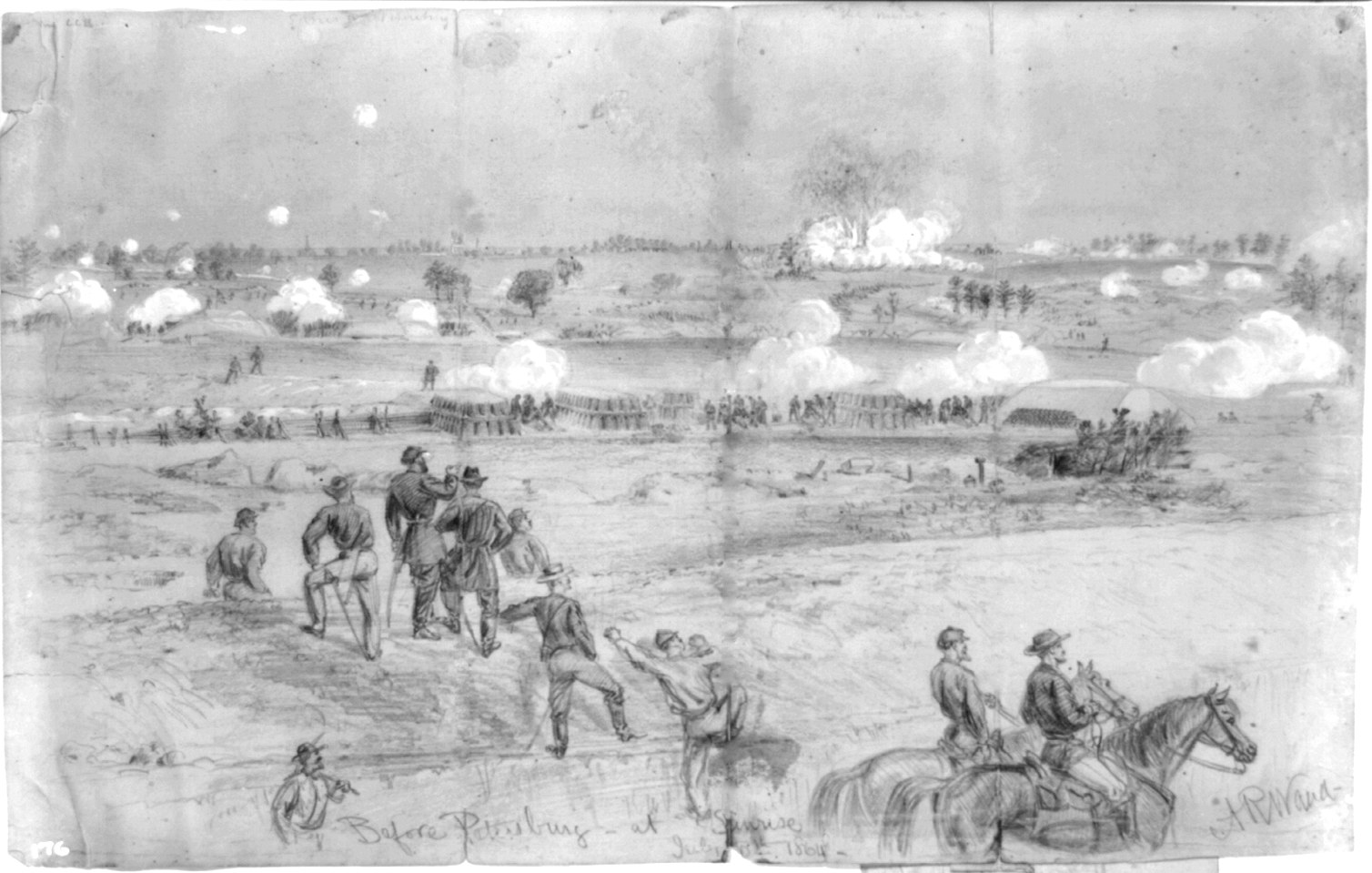 "On the morning of June 16 the brigade moved out from its breastworks, charged and entered the Confederate fortifications, which it held during the day, the 9th participating in several skirmishes, and on retiring burned all the buildings which had been used by Beauregard as headquarters and for other purposes. On June 21 they 9th crossed the Appomattox and took possession of the rifle-pits beyond the City Point & Petersburg railroad, where on the day following it assisted in repelling a charge of the enemy, losing 1 man killed. It remained in the works some days longer, participating in several sharp conflicts brought on by the enemy, who was in all cases repulsed. There in the front line the regiment remained, with brief intervals of relief in the second line, until July 29, losing several men, but not having any pitched engagement.
"On the morning of June 16 the brigade moved out from its breastworks, charged and entered the Confederate fortifications, which it held during the day, the 9th participating in several skirmishes, and on retiring burned all the buildings which had been used by Beauregard as headquarters and for other purposes. On June 21 they 9th crossed the Appomattox and took possession of the rifle-pits beyond the City Point & Petersburg railroad, where on the day following it assisted in repelling a charge of the enemy, losing 1 man killed. It remained in the works some days longer, participating in several sharp conflicts brought on by the enemy, who was in all cases repulsed. There in the front line the regiment remained, with brief intervals of relief in the second line, until July 29, losing several men, but not having any pitched engagement.
"On the 29th marching orders were received and the command proceeded to a new position to act as a reserve to the 9th corps in front of which the 'Burnside Mine' was exploded on the 30th. A day or two afterward it returned to its position and again went into its entrenchments, remaining for a fortnight exposed to a steady fire from the enemy. On Aug. 16, Maj. Hufty was wounded in the left arm, and the staff of the regimental state colors was cut down by Confederate sharpshooters — nine bullets passing through the colors. [see also the Battle of the Crater]
"On Oct. 21, 108 men of the 9th, whose term of service had expired, left the camp for Trenton, where they were mustered out.
"The regiment having been transferred to North Carolina, on Dec. 9, with detachments of several other regiments and 2 pieces of artillery, advanced from Plymouth in the direction of Gardner's Bridge, where the enemy's cavalry was met in some force. The 9th, with the gallant Stewart at its head, charged on a double-quick, speedily dispersing the Confederates, who left several of their wounded behind. The following day a fierce engagement lasting over an hour took place at Foster's bridge, when the enemy again withdrew, destroying the bridge as he retired. In this affair the 9th had 2 men wounded, but took a number of prisoners, including a lieutenant, who took the oath and followed the column for several days.
"The regiment also took a prominent part in the engagement at Butler's Bridge on the day following. Advancing on the line of the railroad leading to Goldsboro, the command on March 7, 1865, reached a point 5 miles east of Southwest Creek, where the enemy was encountered in strong force, and a sharp skirmish ensued, the 9th being engaged during the entire day. That night the regiment fell back half a mile, joining the line of battle, where it remained during the following day behind hastily constructed breastworks.
"In the night fighting was renewed, the enemy, late in the afternoon, making seven distinct charges on the Union left, resting on Wise's Forks, but was each time repulsed. The 9th on this day was ubiquitous, moving rapidly from one point to another — at one time repulsing a charge on the left, at another returning on the double-quick to the center, charging the foe — being ever in the thickest of the conflict and always at the very front.
"The following day a force of eleven brigades charged in solid column several times in succession, but their desperate assaults were fruitless, the Federal line standing as immovable as a wall of granite. The loss of the regiment amounted to 1 officer and 9 men wounded. At Goldsboro the enemy had a force of 1,500 cavalry and 225 infantry. Brisk skirmishing was commenced, but the Confederates were steadily driven, the 9th pushing forward with resistless velocity in its eager desire to enter the city, and it was the first Federal flag raised over Goldsboro.
"The war soon closed and the regiment was mustered out of service at Greensboro, N. C, July 12, 1865. The total strength of the regiment was 2,701, and it lost, by resignation 36, by discharge 352, by promotion 48, by transfer 537, by death 254, by desertion 167, by dismissal 1, not accounted for 36, mustered out, 1,270."
Runyon mustered out with his regiment at Greensboro, NC. One source records his service as distinguished. He returned to NJ and married Eleanor "Ella" A Sofield. They farmed in North Brunswick Twp., Middlesex Co., NJ, in 1880 and had no children. In 1890, Runyon filed for a veteran's pension listed as an "invalid". I suspect he filed under the new rules allowing all veterans to claim a benefit since, they were still farming in Piscataway Twp., NJ, at the time of the 1900 census. By 1910, they were living in Highland Park, Middlesex Co, NJ. GGreat-Aunt Ella died 2 March 1919 and does not appear on the 1920 census with GGreat-Uncle Runyon still in Highland Park. At that time, his younger brother, William and Williams wife, Ernestine, are known as Uncle Will and Aunt Dolly to their State Street neighbors in Perth Amboy, Grandpa Harry R and Grandma Francis V Wilson and all their children.
Great Great-Uncle Runyon and his wife are buried at Saint James Episcopal Church Cemetery in Edison, NJ. Oddly, his listing on Find-A-Grave with photo of the grave marker is marked as J. Runyon Giles and the marker reads Runyon P. Giles. I suspect these notations are sadly in error. I have submitted a correction to the listing.
A note about Civil War Pension Records and the reference to "invalid". I find some explanation that pension requirements as of 1862 "stipulated that only those soldiers whose disability was incurred as a direct consequence of . . . Military duty or developed after combat from causes which can be directly traced to injuries received or diseases contracted while in military service could collect pension benefits."
So Great Great-Uncle Joel Giles would be confirmed to have received injuries, having filed for a pension shortly after his return in 1863. It may be that Joel's brother, Runyon V Giles, and John T Jackson, if they sustained injuries, did not disable them until later in life. The rules changed in 1890. The form looks just like the older forms so it's unclear if the reference to "invalid" truly reflects a battle injury that later disabled them or just that they were veterans filing when the rules changed.